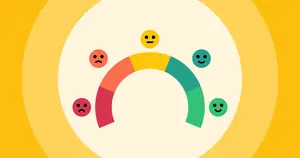What are Cross-functional teams and examples? Traditional businesses prefer a hierarchical structure with a top-down management approach. But modern business looks for cross-functional teams where each member can work well independently and with the stranger team without much preparation.
Check out the top 4+ cross-functional teams examples that might give you more insight into how today's businesses work to succeed in the competitive landscape.
Check out: Ultimate Hierarchical Organizational Structure | 3+ Practical Examples, Pros and Cons
Table of Contents
- What is a Cross-functional Team?
- Why are Cross-functional Teams Important?
- Good Cross-functional Teams Examples
- Key Takeaways
- Frequently Asked Questions
Tips for Better Team Engagement

Make Your Own Quiz and Host it Live.
Free quizzes whenever and wherever you need them. Spark smiles, elicit engagement!
Get started for free
What Is a Cross-functional Team?
A cross-functional team is a group of people from different parts of a company or organization who work together to solve a specific problem or complete a project. They bring different skills and expertise to the table and collaborate to achieve a common goal. It's like having a mix of superheroes with different powers coming together to tackle a unique mission.
Cross-functional teams can be found in various industries and settings, from business organizations and research institutions to healthcare, manufacturing, and more. Their ability to harness the collective knowledge and skills of diverse team members can lead to innovative solutions and improved outcomes.
However, managing cross-functional teams can be challenging, as it requires effective communication, collaboration, and coordination among individuals with different backgrounds and priorities.

Why Are Cross-functional Teams Important?
Five key points emphasizing the significance of cross-functional teams include:
- Varied Expertise: Cross-functional teams pool diverse skills and knowledge from different areas, enabling comprehensive problem-solving and the generation of innovative solutions.
- Comprehensive Decision-Making: These teams take into account the broader consequences of decisions, resulting in more well-rounded solutions that consider the entire organization.
- Improved Interdepartmental Communication: Cross-functional teams foster enhanced communication between different organizational units, promoting better collaboration and unity.
- Cultivation of Innovation: The array of perspectives within these teams nurtures a culture of innovation, encouraging creative thinking and the emergence of new, inventive ideas.
- Enhanced Adaptability: In an ever-evolving business landscape, cross-functional teams offer increased adaptability, enabling swift responses to shifts in the market, emerging opportunities, and unforeseen challenges, ultimately ensuring organizational flexibility.
Good Cross-functional Teams Examples
There are many great examples of cross-functional teams in all kinds of industries. The following stories showcase how cross-functional teams and effective leadership contribute to the success and influence of renowned companies in some prominent industries.
#1. Cross-functional Teams Examples in Healthcare: Pharmaceutical Powerhouse
In a leading "Pharmaceutical Powerhouse" company, cross-functional teams play a pivotal role in various aspects of the business. These teams collaborate on drug discovery, development, and regulatory compliance, ensuring that potential drug candidates move through pre-clinical testing and clinical trials successfully. They also work on market access, commercialization, drug safety, and adverse event monitoring, making new treatments available and safe for patients.
In addition, during mergers and acquisitions, cross-functional teams harmonize operations and streamline processes. Moreover, sustainability and ethical practices teams focus on environmentally responsible and ethically sound business practices. These cross-functional teams are essential in driving innovation and compliance, ultimately improving and safeguarding patients' lives.
#2. Cross-functional Teams Examples in Business: Tech Giant
In this tech industry leader, teams are the backbone of innovation and product development. The cross-functional teams examples are a combination of software engineers, hardware experts, designers, marketers, and more to create cutting-edge products. They follow agile methodologies for rapid development, explore emerging technologies, and expand into new markets.
Cross-functional teams are also crucial for cybersecurity, mergers and acquisitions, sustainability, and other strategic initiatives, ensuring the company's continued success and competitiveness in the dynamic tech sector.
#3. Examples of Cross-functional and Virtual Teams: Tech Conglomerate

In the sprawling "Tech Conglomerate," cross-functional and virtual teams are fundamental to its global success. These teams of software developers, engineers, cybersecurity experts, and more collaborate virtually to develop innovative products and software solutions.
They ensure cybersecurity, adapt products for global markets, foster innovation, provide around-the-clock customer support, and coordinate company-wide projects. These virtual teams enable the conglomerate to tap into a diverse, global talent pool, fostering innovation, global expansion, and efficient operations in the dynamic tech industry.
#4. Cross-functional Team Examples in Leadership: Global Financial Institution
In a "Global Financial Institution," effective leadership in cross-functional teams is instrumental for success across various domains. Compliance and risk management teams rely on leaders with legal or compliance expertise to navigate intricate regulatory landscapes. Those steering digital transformation initiatives, often from IT or innovation, provide a clear vision and prioritize projects to modernize operations and enhance customer experiences.
In wealth management, experienced financial advisors lead cross-functional teams to provide personalized services to high-net-worth clients. Investment managers guide teams in making informed decisions on a global investment strategy, adapting to dynamic market conditions. Customer-centric leaders enhance customer interactions to boost loyalty, and integration managers harmonize operations during mergers and acquisitions.
Additionally, corporate responsibility experts drive sustainability initiatives, aligning ethical practices with the institution's values. Effective leadership in these teams ensures they remain cohesive, focused, and capable of addressing complex challenges and opportunities while adhering to regulatory standards and ethical business practices.
Key Takeaways
In conclusion, cross-functional teams are like the assembly of superheroes from different departments, working together to achieve a common goal. Their ability to harness diverse skills and knowledge leads to innovative solutions and improved outcomes.
Cross-functional teams play pivotal roles in various industries, such as healthcare, business, and technology, addressing complex challenges and fostering adaptability, innovation, and collaboration.
Effective leadership within these teams ensures they remain focused and capable of navigating intricate landscapes, ultimately contributing to the success and influence of renowned companies in today's dynamic business environment.
💡You have a networked team and are worried about team engagement and communication?
AhaSlides offers the best templates for you to customize engaging presentations, and team-building activities, leading to 100% increased job performance.
Frequently Asked Questions
What is an example of working in a cross-functional team?
Working in a cross-functional team involves individuals from different departments or functional areas collaborating on a common project or goal. This collaboration allows for diverse thinking, expertise sharing, and the ability to address complex problems from various angles, ultimately leading to more innovative and successful outcomes.
What is an example of cross-department collaboration?
Cross-department collaboration involves employees from various departments working together to achieve a common organizational goal. It leverages diverse skills and knowledge to address complex issues, streamline processes, and attain shared objectives. An example includes a manufacturing company improving sustainability through the collective efforts of operations, R&D, procurement, marketing, HR, finance, legal, and compliance departments.
What are cross-functional product teams?
Cross-functional product teams comprise members from different organizational departments collaborating to develop and manage products. They leverage diverse expertise, share collective responsibility, and prioritize customer-centric approaches. These teams often employ agile methods, emphasize continuous product enhancement, and maintain transparent communication to ensure the creation of successful, well-rounded products.
What are examples of cross-functional decision-making?
In healthcare, a decision-making team of doctors, nurses, IT specialists, and administrators collectively decide on adopting a new electronic health record system, considering usability, security, and cost factors to meet both clinical and technical needs.
Another example could be a retail company forming a team with members from marketing, sales, finance, operations, product development, customer support, and HR to tackle declining sales by making data-informed decisions on multiple aspects of the business.
Companies that use cross functional teams?
Google, Facebook, Netflix, and Amazon...
Ref: Forbes








